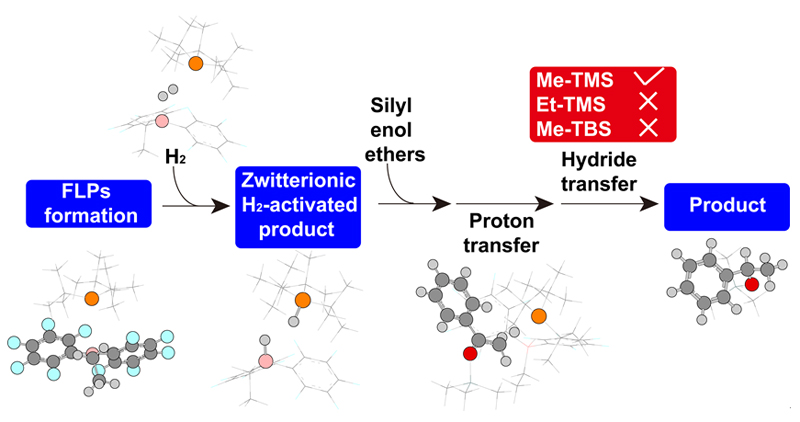摘要/Abstract

“受阻路易斯酸碱对”(FLPs)催化的烯醇硅醚氢化反应是一类重要的直接合成醇类化合物的方法, 然而目前其反应机理仍不明确. 基于此, 以乙基取代的全氟苯基硼作为路易斯酸(Et-B(C6F5)2), 三叔丁基膦(t-Bu3P)作为路易斯碱, 烯醇硅醚化的苯乙酮(Me-TMS)作为底物建立了模型反应, 并使用密度泛函理论系统研究了其催化氢化反应机理. 结果显示: FLPs催化的烯醇硅醚氢化反应从Et-B(C6F5)2和t-Bu3P形成B-P-FLPs开始, 随后会依次经过H2裂解, H+和H-转移等过程, 其中H+转移为决速步, H-转移无势垒, B-P-FLPs生成及H+转移是吸热反应. 升高温度不利于氢化反应发生, 但是增大压力可促进反应进行. 底物取代基效应会影响H-转移过程, 可能使反应不发生.
关键词: 受阻路易斯酸碱对, 烯醇硅醚, 氢化反应, 密度泛函理论
Silyl enol ethers have attracted enormous attention as they could serve as a test bed for the development of novel frustrated Lewis pairs (FLPs) catalytic systems. However, the reaction mechanism of hydrogenation catalysed by metal-free FLPs for these compounds to the corresponding secondary alcohols remains elusive to a large extent in previous studies. We thus performed a thorough investigation on the reaction mechanism by density functional theory (DFT). To illustrate the reaction mechanism of FLPs-catalysed hydrogenation for silyl enol ethers, trimethyl((1-phenylvinyl)oxy)silane (Me-TMS) was chosen as the prototype substrate and toluene as the solvent, where the FLPs were generated by ethylbis(perfluorophenyl)- borane (Et-B(C6F5)2) and tri-tert-butylphosphine (t-Bu3P). The M06-2X functional in connection with 6-31+G(d) basis set was used to optimize the structures of related species including in the Gibbs free energy profiles, and the energies were obtained at M06-2X/6-311++G(d,p) level of theory, where the solvent effect was simulated with the integral equation formalism, polarized continuum mode (IEF-PCM) in both calculations. Our results suggest that the FLPs-catalysed hydrogenation of silyl enol ethers in toluene begins with the formation of B-P-FLPs followed by hydrogen activation, proton transfer and hydride transfer to complete the process. It is obvious from the Gibbs free energy profile that the proton transfer is rate-determining step, the formation of B-P-FLPs and proton transfer are endothermal and the hydride transfer is no barrier. This indicates that the amount of H2 and prototype substrate have significant influence on the FLPs-catalysed hydrogenation of silyl enol ethers. A higher temperature (328.15 K) is disadvantageous to hydrogenation reaction catalysed by FLPs but the reaction could be accelerated under higher pressure (4040 kPa). The Gibbs free energy profile calculations for trimethyl((1-phenylprop-1-en-1-yl)oxy)silane (Et-TMS) and tert-butyldimethyl((1-phenylvinyl)oxy)silane (Me-TBS) reveal that substituent group may inhibit the hydride transfer as the absence of a suitable construction for R-H–-transfer, where the hydride does not direct to the C+ of silyl enol ethers and the distance between C+ and hydride is longer. These results would be helpful to design another novel FLPs-catalysed hydrogenation reaction for silyl enol ethers.
Key words: frustrated Lewis pairs, silyl enol ethers, hydrogenation, density functional theory
PDF全文下载地址:
点我下载PDF
